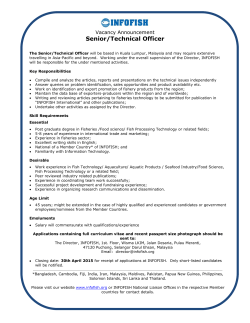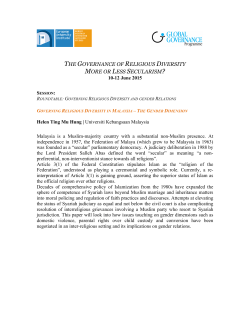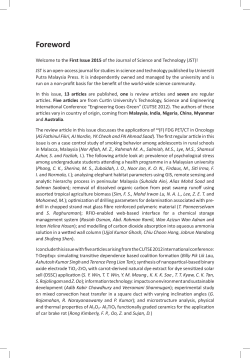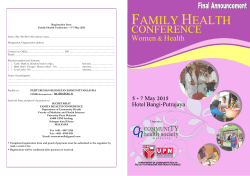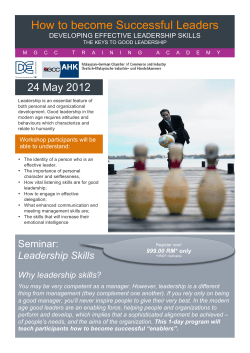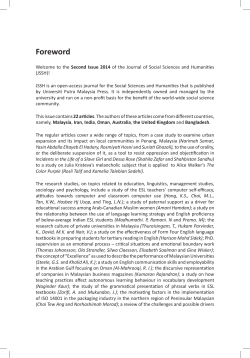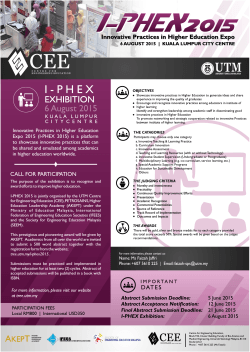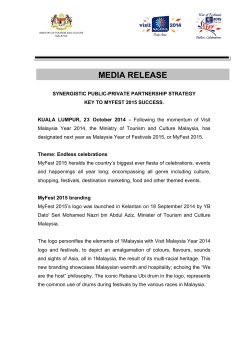
Executive Summary
Executive Summary ELEVENTH MALAYSIA PLAN 2016-2020 ANCHORING GROWTH ON PEOPLE MSG068_11MP_Eng_ES.indd 2 5/16/2015 12:49:53 AM MSG068_11MP_Eng_ES.indd 3 5/16/2015 12:49:53 AM Eleventh Malaysia Plan Executive Summary 4 Executive Summary ELEVENTH MALAYSIA PLAN 2016-2020 ANCHORING GROWTH ON PEOPLE MSG068_11MP_Eng_ES.indd 4 5/16/2015 12:49:53 AM 1 Anchoring growth on people The Eleventh Malaysia Plan, 2016-2020, is the final leg in the journey towards realising Vision 2020. Launched in 1991, Vision 2020 envisions Malaysia as a fully developed country along all dimensions - economically, politically, socially, spiritually, psychologically, and culturally - by the year 2020. Emboldened by the great strides made in the last half decade, the Eleventh Plan reaffirms the Government’s commitment to a vision of growth that is anchored on the prosperity and wellbeing of its rakyat. The Eleventh Plan is premised on a progressive and united Bangsa Malaysia that shares a common commitment towards building a better Malaysia for all Malaysians. The development of the Eleventh Plan was guided by the Malaysian National Development Strategy (MyNDS), which focuses on rapidly delivering high impact on both the capital and people economies at low cost to the government. The capital economy is about Gross Domestic Product (GDP) growth, big businesses, large investment projects, and financial markets, while the people economy is concerned with what matters most to the people, which includes jobs, small businesses, the cost of living, family wellbeing, and social inclusion. Accordingly, the Eleventh Plan is a strategic plan that paves the way for Malaysia to deliver the future that the rakyat desires and deserves. It represents the Government’s commitment to fulfilling the aspirations of the people. The Eleventh Plan, based on the theme “anchoring growth on people”, has six strategic thrusts and six game changers that will transform ideas into reality and address the goals set out in Vision 2020, Malaysia will thus be catapulted towards the end state of being an advanced economy and inclusive nation. MSG068_11MP_Eng_ES.indd 1 5/16/2015 12:49:54 AM Eleventh Malaysia Plan Executive Summary 2 This word cloud captures important concepts, themes, and terms commonly used in the Eleventh Malaysia Plan. MSG068_11MP_Eng_ES.indd 2 5/16/2015 12:49:55 AM 3 In retrospect ONE OF THE BEST Real GDP 6.2% per annum Malaysia has enjoyed one of the best economic growth records in Asia over the last five decades despite a multitude of challenges and economic shocks. The economy achieved a stable real GDP growth of 6.2% per annum since 1970, successfully transforming from a predominantly agriculture-based economy in the 1970s, to manufacturing in the mid1980s, and to modern services in the 1990s. 25X increase in per capita income RM Malaysia rose from the ranks of a low-income economy in the 1970s to a high middle-income economy in 1992 and remains so today. Malaysia’s national per capita income expanded more than 25-fold from US$402 (1970) to US$10,796 (2014) and is well on track to surpass the US$15,000 threshold of a high-income economy by 2020. MALAYSIA MSG068_11MP_Eng_ES.indd 3 5/16/2015 12:49:55 AM Eleventh Malaysia Plan Executive Summary 0.6 % Between 1970 and 2014, the incidence of poverty in general was reduced from 49.3% to 0.6% while hardcore poverty has been eradicated. incidence of poverty Household monthly income 1970 RM264 2014 RM6,141 The mean household monthly income increased more than 20-fold from RM264 in 1970 to RM6,141 in 2014. Similarly, median income increased from RM166 to RM4,585 over the same period. Income inequality has also narrowed, as reflected by the Gini coefficient, from 0.513 in 1970 to 0.401 in 2014. 76.1 Today, Malaysians from all walks of life, irrespective of ethnicity, socio-economic background, and geographic location, enjoy a better quality of life. Approximately 76.1% of households are homeowners, with 75.3% of poor households owning homes as well. % Home Ownership 95.1 of the population have access to potable water MSG068_11MP_Eng_ES.indd 4 Malaysians today live longer, with life expectancy increasing by more than 10 years to 75 years. They are also better educated with 27% of the labour force having a tertiary level qualification, a fourfold increase from 1980. Mobility has improved tremendously with better connectivity provided by extensive road, rail, and air networks. 12 th 20 th TOP % 97.6% have access to electricity 4 20 In 2014, Malaysia was rated the 12th most competitive country among 60 countries in the World Competitiveness Yearbook by the International Institute for Management Development; 20th out of 144 countries in the Global Competitiveness Index (GCI) 2014-2015 by the World Economic Forum; and 18th among 189 economies in the Doing Business Report 2015 by the World Bank. Malaysia also scores highly as a top 20 investor-friendly destination for the period between 2014 and 2018, in the Economist Intelligence Unit’s 2014 Business Environment Rankings. 5/16/2015 12:49:56 AM 5 All these gains were made possible by Malaysia’s development philosophy, which places the prosperity and wellbeing of the rakyat at the heart of economic growth. This commitment can be seen in each successive development policy: New Economic Policy National Development Policy National Vision Policy National Transformation Policy 1971-1990 1991-2000 2001-2010 2011-2020 The New Economic Policy, 1971-1990, focused on poverty eradication irrespective of ethnicity and eliminating identification of ethnicity by economic function. The National Development Policy, 1991-2000, focused on ensuring the balanced development of major sectors of the economy and regions, as well as reducing socio-economic inequalities across communities. The National Vision Policy, 2001-2010, focused on building a resilient and competitive nation. The National Transformation Policy, 2011-2020, maintains the people-centric focus through the New Economic Model, which sets the goal of becoming a highincome economy that is both inclusive and sustainable. This transformation agenda is supported by the Economic Transformation Programme, which focuses on the 12 economic areas that are most critical to the nation’s continued growth, and the Government Transformation Programme, which focuses on transforming areas of public service that are of greatest concern to the rakyat. The Government has also introduced MyNDS to strengthen implementation approach. MSG068_11MP_Eng_ES.indd 5 5/16/2015 12:49:56 AM Eleventh Malaysia Plan Executive Summary 6 The next five years The Eleventh Plan is formulated with the rakyat as the centrepiece of all development efforts. The people economy will be given priority, reinforcing the Government’s commitment to bring further development to the people by enriching their lives, providing people with dignity, and uplifting their potential to partake in the country’s prosperity that is generated. All segments of society must benefit from the country’s economic prosperity in order to create an advanced economy and inclusive nation by 2020. In line with this, for the first time in Malaysia’s history, national growth targets will include not only GDP growth and per capita income, but also household income and the Malaysian Wellbeing Index to assess the impact of economic growth on people’s wellbeing. Average national income The Government aspires for Malaysia to achieve an advanced economy status by 2020, with a national per capita income of Every household will have access to efficient infrastructure and public amenities, quality healthcare and education, quality and affordable housing, and comprehensive support services. MORE THAN US$15,000 The goal is nothing less than a better quality of life for all Malaysians. While there will still be people who earn less than this threshold, all segments of society, irrespective of geography, ethnicity, or income level, are expected to experience an increase in their income and wellbeing. MSG068_11MP_Eng_ES.indd 6 5/16/2015 12:49:57 AM 7 Challenges and opportunities The next five years are expected to be challenging with continued uncertainties in the global economy, particularly given the prospect of low prices for crude oil and other major commodities, and the risk of a slowdown in the economies of major trading partners. On the domestic front, there needs to be greater resolve to boost productivity to drive economic growth; strengthen the fiscal position while ensuring adequate public funding to support continued economic expansion; and raise the average income and share of total income of the bottom 40% household income group (B40 households) to become truly inclusive. The Eleventh Plan also opens up new opportunities, particularly with the establishment of the ASEAN Economic Community (AEC) of more than 600 million people in a single market, which will be a boost to trade and investment. Domestically, Malaysia will exploit its demographic dividend of a young and growing population with a median age of around 30 and a working age population of close to 70% to accelerate growth. Malaysia’s multiracial and multicultural society is another unique asset, which has yet to be exploited to its fullest in terms of its natural affiliation with Islamic nations, the People’s Republic of China, India, and as a rich tourist attraction. MSG068_11MP_Eng_ES.indd 7 Six strategic thrusts Moving forward, the Eleventh Plan provides a critical platform for the country to make vital policy shifts and invent new approaches to address new and existing challenges. It cannot be “business-as-usual” if Malaysia is to make the transition to an advanced economy and inclusive nation in the space of the next five years. Strategic thrusts The Government has defined six strategic thrusts to help Malaysia stay ahead of the challenges and opportunities of the fast-changing global and political landscape. These thrusts aim to comprehensively address the end-to-end needs of the rakyat and the nation. Game changers The Government has also identified six game changers, which are innovative approaches to accelerate Malaysia’s development, that once successfully applied, will fundamentally change the trajectory of the country’s growth. 5/16/2015 12:49:57 AM Eleventh Malaysia Plan Executive Summary and six game changers Four of these game changers are critical to the development of an advanced economy – they aim to unlock productivity for accelerated sectoral growth; unleash innovation to generate new sources of revenue; harness TVET for the transition to a higher-skilled workforce; and develop cities as a source of competitiveness. To ensure that all Malaysians are able to participate in and benefit from this growth, the Government will raise the income and wellbeing of the B40 households. Finally, the Government will embark on green growth to shift the paradigm of sustainability from a narrow focus on natural assets, to include consumption and production processes in all sectors and households. MSG068_11MP_Eng_ES.indd 8 8 Macroeconomic outlook During the Eleventh Plan, real GDP is targeted to expand between 5%-6% per annum. The Gross National Income (GNI) per capita is expected to reach US$15,690 (RM54,100) and therefore exceed the estimated US$15,000 minimum threshold of a high-income economy. The Plan is expected to create 1.5 million jobs by 2020, with targeted improvements in labour productivity through the continuous shift from labour-intensive to knowledge- and innovation-based economic activities. Growth will be driven by the private sector with private investment expanding at 9.4% per annum. All economic sectors will witness strong growth with the manufacturing and services sectors contributing more than 75% of GDP. The external sector is also expected to contribute positively with recovery in exports, and the current account of the balance of payments is projected to remain in surplus at 2.6% of GNI. The Federal Government fiscal position is expected to consolidate further to achieve a balanced budget by 2020. Inflation is expected to remain benign, below 3%, and the economy is anticipated to maintain full employment. Malaysia’s economic fundamentals will be strengthened to achieve sustainable growth by ensuring stable prices and exchange rates, and an adequate level of savings as a source of investible resources. The Government will also promote private consumption, as well as private investment in agriculture, manufacturing, and services to spearhead economic growth, and increase exports by improving product competitiveness, promoting services exports, and diversifying markets. More prudent fiscal management will be introduced to enhance fiscal flexibility, and measures will be undertaken to unlock the potential of productivity to ensure sustainable and inclusive growth. 5/16/2015 12:49:57 AM Strengthening macroeconomic resilience for sustained growth Unlocking productivity potential to ensure sustainable and inclusive growth Nation-wide productivity agenda and implementation plan Enhancing public sector productivity and accelerating regulatory reforms Multidimensional goals, 2016-2020 Greater collaboration in re-skilling and research Ensuring productivity is championed across industries Enterprise-level productivity assessments and targets GDP growth at 5-6% per annum Reducing the cost of doing business Promoting investment to spearhead economic growth Providing performance-based incentives for high-income and knowledge-intensive economic activities Addressing the talent gap and mismatch Labour productivity at RM 92,300 by 2020 from RM77,100 in 2015 Improving access to financing for knowledge-intensive industries Providing tipping point financing through the Facilitation Fund GNI per capita at RM 54,100 by 2020 Increasing exports to improve trade balance Improving the export ecosystem Moving up the value chain Maximising opportunities with strategic partners Increasing external industry expert support Average monthly household income at RM 10,540 by 2020 from RM6,141 in 2014 40% Compensation of employees to GDP by 2020 from Enhancing fiscal flexibility to ensure sustainable fiscal position 34.9% in 2015 Enhancing revenue and implementing more prudent spending measures Malaysian Wellbeing Index (MWI) to increase 1.7% per annum MSG068_11MP_Eng_ES.indd 9 5/16/2015 12:49:57 AM Eleventh Malaysia Plan Executive Summary 10 MSG068_11MP_Eng_ES.indd 10 RM 4.6 % 2.7% billion 6.4% average growth of real private consumption average growth of gross exports RM 57.3 billion 2.8 % unemployment rate by 2020 and full employment throughout Plan period average public investment in current prices average growth of real public investment 291 Fiscal position International trade average private investment in current prices 9.4% Consumption Investment average growth of real private investment Unemployment SELECTED OUTCOMES Macroeconomic prospects, 2016-2020 RM 3.7% trade balance by 2020 131 billion RM average growth of real public consumption 46.5 billion current account of balance of payments at 2.6% of GNI by 2020 below 45% ratio of Federal Government debt to GDP by 2020 Fiscal position to be balanced by 2020 5/16/2015 12:49:57 AM 11 Game Changer Unlocking the potential of productivity Why is productivity important for Malaysia? How will this be achieved? In the past, Malaysia’s economic growth has been predominantly inputdriven, supported by private investments in industry and public investments in infrastructure, utilities, as well as in schools and hospitals. Despite efforts to improve productivity, Malaysia continues to lag behind many high-income economies. For example, Malaysia’s labour productivity level was 32% that of the United States’ and 56% that of South Korea’s in 2013. While Malaysia will continue to boost private investment and undertake public investment during the Eleventh Plan, it will place greater emphasis on increasing productivity to achieve a more sustainable, inclusive, and high rate of economic growth. Malaysia’s approach to productivity will shift from primarily Governmentdriven initiatives at the national level to targeted actions across the public sector, industry players, and individual enterprises, with champions identified to role model change and ensure buy-in across stakeholders. Broad-based initiatives will be developed and tailored for each sector with targets set and monitored. At the national level, productivity-linked incentives will be introduced and regulatory reforms will be accelerated. At the industry level, industry champions will spearhead industry-specific productivity initiatives, while at the enterprise level, incentives and up-skilling programmes will be provided. Collectively, these strategies will produce a set of major shifts as laid out below. What will success look like? During the Eleventh Plan, labour productivity will reach RM92,300 in 2020 from RM77,100 in 2015. In addition, sectoral growth will accelerate due to improvements in productivity. Approach From To Fragmented productivity initiatives, typically at national level Focused and comprehensive strategies at all levels – national, industry, and enterprise Led by Government Spearheaded by industry champions and industry associations, and supported by Government via the National Productivity Council Focused on manufacturing sector and selected services subsectors Covers all sectors, including agriculture, construction and the public sectors Generic programmes without clear targets Programmes closely aligned with industry needs as per relevant industry master plan Champion Industry focus Program design Regulation revamp Oversight MSG068_11MP_Eng_ES.indd 11 Incentives not linked to performance Programme incentives linked to outcomes Little to no linkages between regulations or policies with productivity Linkages established between government regulations or policies with productivity Oversight only at the national level Increased oversight across enterprise, industry, and national level 5/16/2015 12:49:57 AM Eleventh Malaysia Plan Executive Summary 12 Game Changer Uplifting B40 households towards a middle-class society Why is uplifting the B40 households important for Malaysia? middle-class society will grow to 45% by 2020. The mean income of the B40 households will double to RM5,270 in 2020 from RM2,537 in 2014. More B40 households will have family members with tertiary education, from 9% in 2014 to 20% in 2020. The income share of the B40 to national household income will also increase from 16.5% in 2014 to 20% in 2020. Today, there are 2.7 million B40 households with a mean monthly household income of RM2,537. As Malaysia continues to grow, the B40 households should not miss out on the opportunities that come with national prosperity. Allowing the B40 households to remain in their current socio-economic status will create social costs for all Malaysians, as it reduces the number of skilled workers needed to grow national output, perpetuates urban inequality, and limits the growth potential of rural and suburban areas. How will this be achieved? What would success look like? All B40 households regardless of ethnicity will be given greater focus, especially the urban and rural poor, low-income households, as well as the vulnerable1 and aspirational2 households. The size and composition of Approach Scope Characteristics The Government will implement strategies to raise the income and wealth ownership of the B40 households, address the increasing cost of living, and strengthen delivery mechanisms for supporting B40 households. The Government will also introduce the Multidimensional Poverty Index (MPI) to ensure that vulnerability and quality of life is measured in addition to income. The major shifts that will occur are set out below: From To Lifting B40 households above the poverty line through improved income levels and assistance with living costs Uplifting B40 households to middle-class society by further improving income levels and wealth creation, as well as increasing education and skill levels Assisting B40 households with individual micro-enterprises Fostering community and social-based enterprises in the B40 community, in addition to individual enterprises Focus on developing microentrepreneurship and economic activities in low-value, traditional industries Building capacity to participate in high-productivity, innovative, and creative economic activities B40 households have low wealth and non-financial asset ownership, and are easily affected by economic shocks B40 households are able to save and build wealth including through non-financial asset ownership, making them more resilient to economic shocks B40 households are highly reliant on government assistance B40 households are independent and rely less on government assistance programmes 1 Vulnerable households refer to households with income between Poverty Line Income (PLI) and 2.5 times PLI. 2 Aspirational households refer to households with income between 2.5 times PLI and national mean income. MSG068_11MP_Eng_ES.indd 12 5/16/2015 12:49:57 AM 13 Game Changer Enabling industry-led Technical and Vocational Education and Training (TVET) From Supply matches demand, and there are robust quality control mechanisms which ensure that all public and private institutions meet quality standards; Industry and TVET providers collaborate across the entire value chain from student recruitment, through to curriculum design, delivery, and job placement; and Students are well-informed of the opportunities that TVET can offer and view TVET as an attractive pathway. Students also have access to a variety of innovative, industry-led programmes that better prepares them for the workplace. How will this be achieved? Achieving these aspirations will require harmonising and streamlining how the system currently operates to reduce fragmentation across the various public and private stakeholders. Furthermore, efforts will be made to encourage industry-led interventions and programmes as they are the stakeholders best placed to ensure that the supply of graduates meet their requirements. A summary of the major shifts that will be undertaken are set out as follows: MSG068_11MP_Eng_ES.indd 13 Programme delivery An effective and efficient TVET sector is one where: Capacity What would success look like? Profile Under the Eleventh Plan, 60% of the 1.5 million jobs that will be created will require TVET-related skills. Meeting this demand will require Malaysia to increase its annual intake gradually from 164,000 in 2013 to 225,000 in 2020. Yet, the challenge is not merely about numbers. Industry feedback consistently reveals a disconnect between the knowledge, skills, and attitudes these graduates possess, and what is required in the workplace. Governance Why is TVET important for Malaysia? To 2 Accreditation Agencies (MQA and DSD) with different sets of qualifications Single qualification system adopted by both MQA and DSD Different quality rating systems for public and private TVET institutions, depending on which Ministry the institution is registered with Single rating system for both public and private TVET institutions Design and delivery of curriculum led by individual TVET institutions or Government Design and delivery of curriculum led by industry, in partnership with TVET institutions and Government No specialisation among TVET institutions Institutions to specialise in and create Centres of Excellence in niche areas of expertise 164,000 intake in 2013 225,000 intake per annum in 2020, by maximising use of existing institutions Limited recognition and low premium Career of choice for students 5/16/2015 12:49:57 AM Eleventh Malaysia Plan Executive Summary 14 Game Changer Embarking on green growth Why is green growth important for Malaysia? Malaysia, like many countries across the world, is grappling with the challenge of balancing a growing population and demand, with a natural environment that is increasingly under stress. In the global context of increasing intensity and frequency of extreme weather events, adopting green growth has now become an imperative for Malaysia. It represents Malaysia’s commitment to renew and, indeed, increase its commitment to the environment and long-term sustainability. What will success look like? A successful green growth trajectory will ensure: Detrimental impact of socio-economic activity on environmental systems is reduced; Development gains are protected, thus ensuring wellbeing of people across generations; and Energy use is efficient and renewable energy is widely used. How will this be achieved? Achieving these aspirations requires a fundamental shift away from a ‘grow first, clean up later’ development model towards one that views resilient, low-carbon, resource-efficient, and socially inclusive development as an upfront investment that will yield future gains over multiple generations to come. This requires fundamental changes across every major dimension including how policy is determined, how institutions are regulated, how responsibilities are shared, and how people value their environment. From Natural capital, including forested areas, biodiversity, and water resources as well as its ecosystems, is valued and sustainably managed; Quantity of growth landfill Climate change mitigation and adaptation as a Government’s Resource and energy responsibility intensive Climate change mitigation and adaptation as an Shared responsibility Resource and energy cost Quality of growth To Waste to that takes into consideration the cost to the climate, environment, and the nation’s natural resources MSG068_11MP_Eng_ES.indd 14 Waste as resource that can be reused through recycling and recovery, for power generation, and other waste to wealth initiatives investment that is accounted for during the upfront planning and investment stages between the government, private sector, and individual citizens efficient in balancing both supply-side and demand-side considerations and constraints 5/16/2015 12:49:57 AM 15 Game Changer Translating innovation to wealth Why is innovation important for Malaysia? Innovation is a key driver for economic growth as it raises productivity through new or improved processes, technologies, and business models. In addition, innovation can create additional sources of revenue through differentiated products and services that serve unmet customer needs. As Malaysia continues to move towards a high-value, knowledge-based economy with a strong focus on the services and manufacturing sectors, innovation will be crucial to raise the overall efficiency and thus productivity of each sector. What will success look like? In the enhanced innovation ecosystem, there will be greater collaboration and integration across industry, academia, and communities. Research will be closely aligned with industry demand, and the private sector will be active partners in the research, development, commercialisation, and innovation (R&D&C&I) process by contributing funds, expertise, and other resources. Communities Enterprise innovation Social innovation MSG068_11MP_Eng_ES.indd 15 will be actively engaged in addressing social issues through a wholesociety approach in the provision of social services. There will be a greater return on investment from innovation. How will this be achieved? The Eleventh Plan will focus on strengthening relational capital by improving collaboration among all stakeholders. Innovation will be targeted at both the enterprise and societal level, instead of previous efforts which focused primarily on national-level initiatives. At the enterprise level, initiatives will enhance demand-driven research, improve collaboration between researchers and industries, and encourage private investment in R&D&C&I. At the societal level, communities will be encouraged to provide input into social service delivery mechanisms, while a social financing model will be developed to assist communities to fund new initiatives. Collectively, these strategies will produce a set of major shifts as set out in the table below: From To Collaboration between industry and research institutes is limited, resulting in R&D output that is not linked to industry demand Better partnerships between industry and researchers, with industry helping to shape research to ensure relevance to business, and contribute ideas, infrastructure, tools, and expertise Investments in R&D have low returns and do not drive competitiveness and productivity for industry Integrated R&D&C&I initiatives generate high return on investment over time and stimulate productivity growth High investments in social services but delivery is ineffective Focus on streamlining social services delivery by incorporating feedback from the community in line with the “whole-society approach” Communities remain dependent on the government Delivery supported by a Social Financing Model and outcomebased funding to provide communities with avenues to invest in innovative initiatives 5/16/2015 12:49:58 AM Eleventh Malaysia Plan Executive Summary SELECTED OUTCOMES 0.385 MSG068_11MP_Eng_ES.indd 24 reduction in Gini coefficient from 0.401 in 2014 RM 5,270 RM 5,701 Improving overall income inequality OUT OF median monthly household from RM2,629 in 2014 Uplifting B40 households towards a middle-class society Empowering communities for a productive and prosperous society 8 10 mean monthly household income from RM2,537 in 2014 average score in the Family Wellbeing Index 3,000 km paved roads will be constructed 90,000 additional houses will be supplied with clean and treated water 36,800 additional houses will be supplied with electricity Transforming rural areas to uplift wellbeing of rural communities Accelerating regional growth for better geographic balance RM 236 billion realised investment Enhancing Bumiputera Economic Community (BEC) opportunities to increase wealth ownership AT LEAST 60% AT LEAST 59 % participation of women in the workforce from 53.6% in 2014 470,000 24 job opportunities created 90% AT LEAST 30% participation of Bumiputera in skilled occupation category Bumiputera households own a residential unit Bumiputera corporate equity ownership with effective control 5/16/2015 12:49:58 AM Strategic thrust 2: Improving wellbeing for all Achieving universal access to quality healthcare Enhancing targeted support, particularly for underserved communities Improving system delivery for better health outcomes Expanding capacity to increase accessibility Intensifying collaboration with private sector and NGOs to increase health awareness MSG068_11MP_Eng_ES.indd 25 Providing adequate and quality affordable housing to poor, low- and middle-income households Increasing access to affordable housing for targeted groups Strengthening planning and implementation for better management of public housing Encouraging environment-friendly facilities for enhanced liveability Creating safer living environments for thriving communities Enhancing crime prevention by enforcement agencies, private players, and the public to elevate perception of feeling safe Tightening regulations and strengthening enforcement to stem crime Promoting crime awareness for effective prevention Improving road safety and emergency services to reduce fatalities Improving road safety to reduce accidents Improving emergency services to save lives Enculturating the spirit of 1Malaysia to foster social cohesion and national unity Promoting social integration and ethics to foster a united and moral society Intensifying stakeholder engagement to build a shared sense of responsibility Promoting sports for healthy living and unity Promoting mass sports participation at all levels of society to instil a sports culture Developing youth leadership in sports Developing high performance athletes for global prominence Enhancing rehabilitation, treatment, and aftercare to reduce recidivism among ex-inmates and relapse among drug addicts 5/16/2015 12:49:58 AM Eleventh Malaysia Plan Executive Summary SELECTED OUTCOMES 1.7% MSG068_11MP_Eng_ES.indd 26 Achieving universal access to quality healthcare 2.3 1:400 6,800 606,000 1 Increase per annum, compared to 1.1% during the Tenth Plan Houses to be constructed/ repaired for the poor Houses to be developed for low- and middle-income households Promoting sports for healthy living and unity Number of schools with Kelab Rukun Negara 50 % Minimum percentage of Malaysians who embrace a sports culture Improving road safety and emergency services to reduce fatalities Doctor to population ratio Providing adequate and quality affordable housing to poor, low- and middle-income households 47,000 Malaysian Wellbeing Index Enculturating the spirit of 1Malaysia to foster social cohesion and national unity Hospital beds per 1,000 population1 26 Creating safer living environments for thriving communities 60% 5 % Percent of population feeling safe Annual reduction in crime index 8 Optimised emergency response time minutes Road fatalities index per 10,000 registered vehicles 2.0 8 Optimised police response time minutes Includes public and private hospitals, maternity and nursing homes, hospices and ambulatory care centres. 5/16/2015 12:49:59 AM Strategic thrust 3: Accelerating human capital development for an advanced nation Improving labour market efficiency to accelerate economic growth Improving labour productivity and wages through the shift to high skilled jobs Enhancing labour market operations to maximise efficiency and effectiveness Improving management of foreign workers Improving the quality of education for better student outcomes and institutional excellence Enhancing access and quality to improve student outcomes Enhancing governance and stakeholder partnerships for better school support Raising the quality of graduates and programmes, and strengthening research for innovation Strengthening IHE governance and financial sustainability towards institutional excellence MSG068_11MP_Eng_ES.indd 27 Transforming TVET to meet industry demand Strengthening the governance of TVET for better management Enhancing quality and delivery of TVET programmes to improve graduate employability Rebranding TVET to increase its attractiveness Strengthening lifelong learning for skills enhancement Improving effectiveness of programmes to meet learning needs Improving regulatory and funding support to broaden access 5/16/2015 12:49:59 AM SELECTED OUTCOMES Eleventh Malaysia Plan Executive Summary MSG068_11MP_Eng_ES.indd 28 Improving labour market efficiency to accelerate economic growth 3.7% Per annum labour productivity target in the Eleventh Plan, compared with 2.6% in the Tenth Plan Transforming TVET to meet industry demand 225,000 Intake of SPM leavers to TVET programmes; an increase from 164,000 in 2013 Strengthening lifelong learning for skills enhancement Improving the quality of education for better student outcomes and institutional excellence 58% Increase in number of employees that will benefit from expansion of the HRDF Act; from 1.77 million employees in 2014 to 2.8 million in 2020 Malaysia aims to be at least on par with the international average in PISA and TIMSS assessments TOP 100 40% Compensation of employees to GDP in 2020; an increase from 33.6% in 2013 RM 2,500 Monthly median wage in 2020; an increase from RM1,575 in 2014 28 2 universities in the top 100 of the QS World University Rankings 100% Student enrolment from preschool to upper secondary 5/16/2015 12:49:59 AM Strategic thrust 4: Pursuing green growth for sustainability and resilience Strengthening the enabling environment for green growth Strengthening governance to drive transformation Strengthening resilience against climate change and natural disasters Strengthening disaster risk management (DRM) Enhancing awareness to create shared responsibility Establishing sustainable financing mechanisms Improving flood mitigation Enhancing climate change adaptation Adopting the sustainable consumption and production concept Creating green markets Increasing share of renewables in energy mix Conserving natural resources for present and future generations Ensuring natural resources security Enhancing alternative livelihood for indigenous and local communities MSG068_11MP_Eng_ES.indd 29 Enhancing demand side management (DSM) Promoting low carbon mobility Managing waste holistically 5/16/2015 12:49:59 AM Eleventh Malaysia Plan Executive Summary UP TO SELECTED OUTCOMES 40% MSG068_11MP_Eng_ES.indd 30 DSM 2,080 MW Fomulation of a comprehensive demand side management master plan In renewable energy installed capacity 30 Reduction in GHGs emission intensity of GDP compared to 2005 level At least 20% 22% Government procurement to be green Recycling rate of household waste Adopting the sustainable consumption and production concept Strengthening resilience against climate change and natural disasters DRM 2 million Conserving natural resources for present and future generations National crisis and disaster management centre to enhance capacity for disaster preparedness and response 17% Terrestrial and inland water areas gazetted as protected areas People protected through flood mitigation projects 10 Coastal and marine areas gazetted as protected areas % 5/16/2015 12:50:00 AM Strategic thrust 5: Strengthening infrastructure to support economic expansion Encouraging sustainable energy use to support growth Strengthening stakeholder coordination and collaboration in the energy sector Ensuring the security of supply and reliability for the oil and gas subsector within a market-based approach Building an integrated need-based transport system Enabling growth in the oil and gas subsector Enhancing connectivity across transport modes and regions Improving safety, efficiency and service levels of transport operations Expanding port capacity, access and operations Managing supply diversity for security of the electricity subsector Improving the sustainability, efficiency and reliability of the electricity subsector Strengthening regulatory and institutional framework for the transport industry Continuing the transition to a new water services industry framework Raising the financial sustainability of the water services industry Unleashing growth of logistics and enhancing trade facilitation Strengthening institutional and regulatory framework Enhancing trade facilitation mechanism Deploying technology in the logistics chain Building freight infrastructure efficiency and capacity Strengthening capabilities of logistics service providers Expanding network and treatment plant capacity through infrastructure investment and use of efficient technology Increasing efficiency and productivity of water and sewerage services Strengthening the regulatory framework of the water services industry MSG068_11MP_Eng_ES.indd 31 Improving coverage, quality and affordability of digital infrastructure Expanding and upgrading broadband infrastructure Migrating to Digital Terrestrial Television (DTT) Increasing affordability and protection for consumers Strengthening infrastructure for smart cities 5/16/2015 12:50:00 AM SELECTED OUTCOMES Eleventh Malaysia Plan Executive Summary MSG068_11MP_Eng_ES.indd 32 40% Public transport modal share in GKL/KV 3,000 Paved rural roads constructed km Malaysian Aviation Commission as newly established regulator Building an integrated need-based transport system 95% 1% 46 areas TOP 10 Of GNI per capita for fixed broadband cost 80% Sewerage connected services coverage, especially in main cities, by 2020 Nationwide with Digital Terrestrial Television roll-out in 2016-2017 with all services available after ASO completion 25 Non-revenue water by 2020 % Continuing the transition to a new water services industry framework Encouraging sustainable energy use to support growth EURO 4M, EURO 5 standards for clean fuel and B15 (15% biodiesel blending) roll-out by 2020 Annual growth of transport and storage subsector In the World Bank Logistics Performance Index 99% Population served by clean and treated water by 2020 Improving coverage, quality, and affordability of digital infrastructure Unleashing growth of logistics and enhancing trade facilitation 8.5% Populated areas covered by broadband infrastructure 32 3.5 MTPA Additional LNG import capacity through RGT-2 in Pengerang, Johor 7,626 MW 300,000 BPD New generation capacity installed in Peninsular Malaysia by 2020 Additional refining capacity by 2019 5/16/2015 12:50:00 AM Strategic thrust 6: Re-engineering economic growth for greater prosperity Investing in competitive cities and regional economic corridors development Developing city competitiveness master plans for four major cities Strengthening corridors to fuel regional development Transforming services Fostering a dynamic environment for knowledge-intensive services Implementing comprehensive and integrated governance reforms Stepping up internationalisation of services firms Enhancing management of investment incentives Energising manufacturing Modernising agriculture Moving towards complex and diverse products Enhancing productivity through automation Stimulating innovation-led growth Strengthening growth enablers Ramping up internationalisation Growing dynamic SMEs Strengthening human capital development Enhancing ease of doing business Increasing demand for SME Products and Services MSG068_11MP_Eng_ES.indd 33 Improving productivity and income of farmers, fishermen and smallholders Enhancing knowledge content Promoting training and youth agropreneur development Driving productivity Strengthening institutional support and extension services Building capacity of agricultural cooperatives and associations along the supply chain Fostering sustainable practices Increasing the internationalisation of construction firms Improving market access and logistics support Scaling up access to agricultural financing Intensifying performance-based incentive and certification programmes Expanding modern services Enhancing productivity through automation and innovation Transforming construction Enterprise innovation Creating home-grown champions Developing SMEs in Sabah and Sarawak Strengthening the governance mechanism Translating innovation to wealth Enhancing demanddriven research Strengthening industryacademia collaboration through intermediaries Promoting private financing of research, development, commercialisation, and innovation Social innovation Strengthening collaboration through a whole-society approach Developing a social financing model Promoting higher order thinking skills to develop a dynamic society 5/16/2015 12:50:00 AM SELECTED OUTCOMES Eleventh Malaysia Plan Executive Summary MSG068_11MP_Eng_ES.indd 34 Contribution of RM519 billion or 8.2% to GDP with 1.6 million jobs Contribution of RM2,421 billion or 38.4% to GDP with 9.5 million jobs across all sectors Growth of Growth of Growth of 6.9 3.5 9.3 Contribution of RM3,488 billion or 56.5% to GDP with 9.6 million jobs % per annum 3,488 RM billion Transforming services Energising manufacturing 1,417 RM % per annum 519 RM billion Modernising agriculture Transforming construction 327 RM Growth of Growth of per annum Contribution of RM1,417 billion or 22.5% to GDP with 2.8 million jobs 70% 2,421 RM billion 10.3% per annum Contribution of RM327 billion or 5.5% to GDP with 1.2 million jobs % of GDP per annum billion 5.1 2 % billion % GERD Growing dynamic SMEs 34 Gross expenditure on R&D of GDP 70% of total R&D expenditure by Business Enterprises Translating innovation to wealth Investing in competitive cities and regional economic corridors 4 236 RM billion Cities with City Competitiveness Masterplans developed Realised investment with 470,000 job opportunities created across five regional economic corridors 5/16/2015 12:50:00 AM Transforming public service for productivity Enhancing project management for better and faster outcomes Capitalising on local authorities for quality services at the local level Strengthening project planning Enhancing implementation efficiency Improving monitoring and evaluation focused on outcomes Strengthening talent management for the public service of the future Appointment on a contractual basis to secure top talent Providing flexible work arrangements to maximise productivity Empowering and improving accountability of local authorities Strengthening service delivery by local authorities Empowering Ministries to customise talent management Strengthening collaboration for stimulating local economic development Upgrading public sector training to improve relevance and impact Intensifying public engagement and data sharing by local authorities Enhancing service delivery with citizens at the centre Reducing public service bureaucracy and non-core services Rationalising public sector institutions for greater productivity and performance Realigning public sector institutions and reducing overlapping roles Rightsizing the public service for better productivity and capabilities Introducing exit policy for underperformers MSG068_11MP_Eng_ES.indd 35 Improving delivery process to increase responsiveness Leveraging data to enhance outcomes and lower costs Expanding outreach of services with greater public engagement Increasing accountability with greater focus on transparency and outcomes 5/16/2015 12:50:01 AM SELECTED OUTCOMES Eleventh Malaysia Plan Executive Summary MSG068_11MP_Eng_ES.indd 36 Top 10 in the Government Efficiency sub-index of the World Competitiveness Yearbook Top 15 in the Online Service sub-index of the UN e-Government Development Index TOP TOP 10 Capitalising on local authorities for quality services at the local level Embedding community expectations into local authority KPIs TOP 15 Rationalising public sector institutions for greater productivity and performance Conducting a comprehensive audit across institutions and agencies Top 30 in the Corruption Perception Index by Transparency International 30 Enhancing service delivery with citizens at the centre Establishing cloud computing for consolidation and data sharing U-Customs providing a national single window for trade facilitation Enhancing project management for better and faster outcomes Establishing a public sector comparator (PSC) Strengthening talent management for the public service of the future Providing flexible working arrangement schemes 36 The Government is committed to transforming the public service by becoming more citizen-centric and enhancing the productivity and efficiency of service delivery. The aspiration is to deliver more accessible public services with multi-skilled talent, as well as less bureaucracy, hierarchy, and centralisation. Key initiatives include: Citizens at the centre: Public services will increasingly be co-created by the rakyat through crowdsourcing and greater engagement to understand preferences and needs. Urban, Rural and Mobile Community Transformation Centres (CTCs) will be maximised to consolidate services closer to the rakyat. Frontline services will be integrated from the perspective of the rakyat (rather than traditional agency and ministry perspectives), with back-end processes consolidated to deliver faster response times. Productivity and efficiency: Institutions, commissions, and agencies will be rationalised to reduce overlaps and redundancies to create a leaner, more agile, and more responsive public sector. This will include rightsizing the public service, introducing exit policy for underperformers, and integrating productivity indicators into KPIs of ministries and local authorities. Digital government: 77% of government services are now online with more services available via the single signon. Mobile platform will be given focus to increase usage and outreach. The National Open Data initiative will allow interactive feedback, transparency, data analyses, and open innovation by businesses and individuals. 5/16/2015 12:50:01 AM 37 Malaysia beyond 2020 The Eleventh Plan not only marks the culmination of a 30-year journey towards Vision 2020; it also sets the stage for the next horizon of growth. Post-2020, the challenge will be to raise the bar even higher on the country’s growth prospects along three dimensions, namely economy, people, and environment. The vision is for all Malaysians to have an unshakeable national identity and clear moral compass. The country will be governed by trusted and independent executive, legislative, and judicial institutions that protect all Malaysians equally. Malaysians will have a government that delivers, led by leaders with integrity and conviction who embrace the concept of amanah. Malaysia will punch above its weight in the international arena, both as a strong independent nation and through prominent Malaysian thought leaders in various fields. The economy will be progressive, inclusive, and adaptable for the future, with highly productive worldclass cities and thriving rural areas. All Malaysians will be able to participate in and benefit from the country’s growth, and enjoy an elevated state of wellbeing. Malaysians will be passionate stewards of the environment and no longer see environmental protection as a trade-off to a strong economy, making Malaysia a truly beautiful place to live for all. One nation, one people, and one aspiration We come from different backgrounds and ethnicities, and speak many languages. But we speak with one voice – that of wanting a better future for our next generation. It is the voice of hope, of solidarity. It is the voice that says we are one. The aspirations described above are neither exhaustive nor conclusive, but are intended to set in motion the prospect for further engagement and serious deliberation. Essentially, Malaysians envision a strong sovereign nation that is progressive and inclusive, and where people treasure unity and celebrate diversity. MSG068_11MP_Eng_ES.indd 37 5/16/2015 12:50:01 AM Eleventh Malaysia Plan Executive Executive Summary 38 Conclusion The Eleventh Plan is significant as it will be the last five-year plan before Vision 2020 is achieved. It provides a crucial platform to ensure that Malaysia transitions to an advanced economy and inclusive nation. Towards this end, the Eleventh Plan has been formulated with the rakyat as the focal point of all development efforts – to enrich their lives, raise their dignity, and enable them to partake in the country’s economic prosperity. Six strategic thrusts and six game changers have been defined to break the country out of “business as usual” practices and set Malaysia on an accelerated growth trajectory. The Eleventh Plan strives for a future that is built on sound macroeconomic policy, inclusiveness so that no Malaysian is left behind, improved wellbeing for all, human capital development that is future-proof, green and sustainable growth, infrastructure that supports economic expansion, and a citizen-centric public service with high productivity. Collectively, these improvements will ensure that everyone, regardless of gender, ethnicity, socio-economic status and geographic location, can live in a truly harmonious and progressive society that bears the mark of an advanced economy and inclusive nation. MSG068_11MP_Eng_ES.indd 38 5/16/2015 12:50:01 AM MSG068_11MP_Eng_ES.indd 39 5/16/2015 12:50:01 AM MSG068_11MP_Eng_ES.indd 40 5/16/2015 12:50:01 AM For further information please contact: Director General Economic Planning Unit Prime Minister’s Department Block B5 & B6 Federal Government Administrative Centre 62502 Putrajaya MALAYSIA Publisher’s Copyright© All rights reserved. No part of this publication may be reproduced, copied, stored in any retrieval system or transmitted in any form or by any means– electronic, mechanical, photocopying, recording or otherwise; without prior permission of the Economic Planning Unit, Prime Minister’s Department, Malaysia. Printed by Percetakan Nasional Malaysia Berhad, Kuala Lumpur, 2015 www.printnasional.com.my Email: cservice@printnasional.com.my Tel: 03-9236 6895 Fax: 03-9222 4773 MSG068_11MP_Eng_ES.indd 1 5/16/2015 12:49:53 AM
© Copyright 2025
